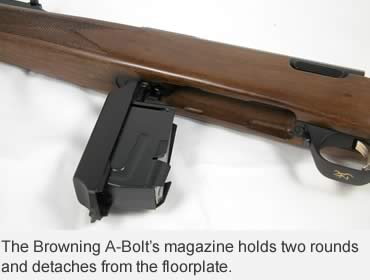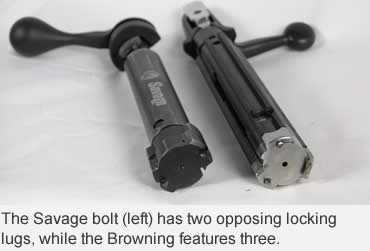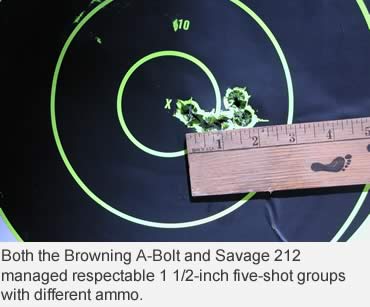Turnbolt shotguns are the hottest tickets in slug gun shooting today.
Photo: Savage bolt actions have a reputation for outstanding accuracy.
Among deer hunters in the shotguns-only environs of rural New York a half-century ago, it was common knowledge that Ithaca Gun and Remington Arms made shotguns, and every other company just tried real hard.
The two companies were major employers in the central part of the state following World War II and Korea, and their products pretty much dominated dealers’ shelves.
Ithaca M37 Deer Slayers and Remington 870 Wingmasters were the ultimate goal for early Baby Boomers, guns that virtually every hunter aspired to eventually own. But you didn’t start there.
In my formative years as a deer hunter, there was always a cousin, neighbor kid or buddy serving their apprenticeship with a clubby bolt-action Mossberg 195, Marlin 55, J.C. Higgins, Stevens or Sears 140.
Turnbolt shotguns were starters reserved for kids or folks who weren’t as serious about deer guns. But all that changed with the advent of rifled barrels and sabot slugs in the late 1980s. From that point to the present, slug gun accuracy evolved from the 40-yard “maybes” to taking deer out to 150 yards and sometimes farther.
Today’s bolt-action slug guns bear little resemblance to yesterday’s simple models. Anyone knowledgeable about slug guns knows solid lockup, a heavy barrel fixed to the receiver and a quality trigger are critical to accuracy.
Thus, the hottest ticket in slug gun shooting today is the bolt action, which boasts all three. Again.
 False Start for Bolt Actions
False Start for Bolt Actions
Yeah, you remember correctly. The rifled-barrel bolt-action shotgun craze initially hit in the 1990s. But it turned out to be a false start before almost flaming out in the waning days of the 20th century.
In the mid-1990s, Marlin introduced its 512 SlugMaster, followed by Browning’s A-Bolt shotgun, Savage’s 210 MasterShot and Mossberg’s 695. All were 12-gauge bolt actions with rifled barrels, representing the cutting edge in fast-advancing slug shooting technology.
But after a quick retail start, the bolt-action slug gun fad faded quickly, for a couple of reasons. Reliably cycling a non-tapered, large-diameter shotgun hull through a bolt action is problematic and prone to failure in excited or unpracticed hands.
Secondly, price points of the new guns varied wildly, and the public ignored quality over affordability.
Mossberg’s 695, a rifled barrel version of its older Maverick 95 bolt gun, was described as a retail home run soon after its introduction in 1995. Marlin’s 512, similarly evolved from the company’s venerable Model 55 Goose Gun in 1994, also sold well when either gun could be routinely found for less than $300. The guns also had clubby stocks and heavy triggers that were difficult to adjust. But they were cheap.
Bolts were simple yet effective. With no lugs on the bolt head, lockup was achieved by simply lowering the bolt handle into a recess in the receiver.
Mossberg dropped the 695 in 1999, and Marlin followed, both citing slacking sales.
The Browning A-Bolt and Savage 210 were essentially 12-gauge versions of proven rifle designs. Both featured smooth, quality rifle bolts with front locking lugs, triggers that ranged from good (Browning) to acceptable (Savage) and heavy rifled barrels.
Although much better in quality, the $800 Browning and $420 Savage couldn’t compete with the eminently more affordable Mossberg and Marlin.
The A-Bolt was introduced in 1994 but didn’t hit dealers until March 1996. Arguably the best production slug gun ever made, the A-Bolt was discontinued due to poor sales in 1999.
Savage had emerged from the ashes of bankruptcy in 1989 under the leadership of Ron Coburn. After a prospective merger with Mossberg fell through in 1995, the company remained small and agile enough to service the niche slug gun market with the superbly accurate 210, despite sales of less than 9,000 units annually.
 Bolt Actions Today
Bolt Actions Today
The 12-gauge Savage 210 thus remained viable through 2009, well after its competition had disappeared. It was always accurate, but a disappointing trigger, boxy integral magazine and some ejection problems limited sales.
A small camp of dedicated slug shooters had lobbied to have Savage’s vaunted Accu-Trigger system integrated into the 210 design, but the required redesign (trigger slot in the 210 receiver wasn’t wide enough) would have hurt the affordability of what was already a limited-interest firearm.
Instead, in 2010, Savage came out with a vastly improved bolt gun, this time in 20 gauge. The 220F, with a fast rifling twist rate, Accu-Trigger system and detachable polymer magazine, set new standards for accuracy and took the slug shooting world by storm.
The 7-pound, 2-ounce gun relegated the 210 to the shadows. The 12 gauge design was discontinued late in 2010 to allow for all-out production of the 220F.
What followed quite naturally a few months later was the new 12-gauge Savage bolt gun, the 212, a beefed-up version of the 220F with an Accu-Trigger and detachable magazine but the same old proven SAAMI-spec 12-gauge 1-in-35 twist rate. The gun, which became available last spring, has an MSRP of $618.
Browning, meanwhile, had apparently long been having second thoughts on the early dismissal of the A-Bolt design. The quality bolt-action shotgun that they simply couldn’t sell in the late 1990s for $700-$800 was, by the 21st century, regularly selling on the used gun market for $1,500-$2,500.
Thus, in 2011, Browning/Miroku reintroduced the walnut-stocked A-Bolt Hunter, albeit at $1,200-plus price ($1,100 for the synthetic-stocked Stalker model and $1,240 for the camo version cloaked in Mossy Oak Breakup).
The A-Bolt is no longer available in a smoothbore version, as was the alternative in the 1990s. The rifled-barrel version has Trego rifle sights, unlike its naked-barreled predecessor.
Otherwise, the new Miroku gun pretty much mirrors the old design, which, as noted, was terrific.
 Comparing the Bolt Actions
Comparing the Bolt Actions
Both the Savage 220/212 and Browning A-Bolt designs feature front-locking rifle-style bolts, free-floating 22-inch rifled barrels, and receivers drilled and tapped to accept scope mounts. In fact, the Savage comes with proprietary scope mounts installed.
The Browning boasts three front-locking lugs and the Savage Mauser-based twin-opposed lugs. Both have 60-degree bolt rotations.
As mentioned, the Browning features rifle sights while the Savage has no sights.
Rifling twist rate for the 20-gauge 220F is the now widely-accepted 1-in-24 inches while the 212 remains the 12-gauge SAAMI standard 1-35. The A-Bolt’s 12-gauge twist is the widely adaptable 1-in-28.
The 7-pound A-Bolt features a two-shot box magazine that attaches the hinged floorplate. In addition to the locking lugs, the gun features a large hook extractor that pulls the shell case against an ejector stud in the left rear of the receiver. Spring-loaded grips in two of the lugs help maintain the extractor’s hold on shotshells.
The front-locking bolt, like the rifle design, turns within a sleeve that remains stationary while the bolt rotates in and out of battery.
The extractor is a slender hook-like affair that rotates with the bolt head and is housed in a slot just above the bottom locking lug. Extraction is theoretically via inertia with a blade contacting the case rim as the bolt reaches the last half-inch of travel.
The 22-inch rifled barrel is threaded to the receiver and secured by Savage’s unique locking nut, long considered the foundation of the design’s renowned accuracy.
One might question the need for the locking nut in a firearm with chamber pressures a fraction of a centerfire deer rifles. But given the fact that a slug must jump a half-inch or more from the chamber to engage the rifling, the nut certainly is part of the gun’s accuracy because it provides a more solid lockup between barrel and receiver and reduces vibration.
As noted, ejecting bulky shotgun hulls from a rifle-sized action with a bolt is problematic, and the old 210 displayed that weakness. I understand that early versions of the 220 ejected too vertically, commonly bouncing hulls off scopes. The post-November 2009 models, however, eject more efficiently.
Add the controlled-round feed with stationary blade ejector, the 1-inch P.A.D. recoil pad and the 220 is, quite simply, a long-action Savage 110 rifle chambered in 20-gauge. That dimensional similarity makes the design more cost efficient, since it uses the same basic receiver. That was probably a factor in bringing out a 20-gauge slug gun before the redesigned 12.
Range Testing
 Recently, I gave the Savage 220F a thorough wringing out at the range and in the field. Literal MOA groups were achievable at distances well beyond the effective range of any 20-gauge slug I’ve tested.
Recently, I gave the Savage 220F a thorough wringing out at the range and in the field. Literal MOA groups were achievable at distances well beyond the effective range of any 20-gauge slug I’ve tested.
The Savage 220F is phenomenal. I believe the combination of the fast-twist rifling and Accu-Trigger makes it nothing less than the most accurate production slug gun ever made.
The 12-gauge Savage 212 and Browning A-Bolt are very good. Shooting a variety of modern high-velocity slugs, both the 212 and the A-Bolt exhibited outstanding accuracy.
Test ammo included Winchester Dual Bonds and Partition Golds, Remington Accu-Tips, Federal Tipped Barnes Expanders, Hornady SSTs and Lightfield Hybred Elite sabots. All provided a good idea of the two guns’ long-range accuracy potential. Both achieved five-shot groups of less than 1 1/2 inches at 100 yards.
The A-Bolt shot three Winchester Dual Bonds into a 1 3/8-inch group. The Savage 212 also shot 3-inch Lightfield Hybred Elites and Remington Accu-Tips into sub-1 1/2-inch groups.
As one might expect of a $1,000-plus gun, the A-Bolt cycled slightly smoother, but is also kicked a tad harder than the Savage.
The Savage’s Accu-Trigger was a bit better than the A-Bolt trigger.
All in all, both models proved to be outstanding performers. Slug guns have certainly come a long way.
Read Recent GunHunter Articles:
• Muzzleloader Myths: Voodoo ballistics and other misconceptions still abound in blackpowder shooting.
• Classic Styling is Everlasting: Jack O’Connor’s favorite Model 70s are great examples of timeless elegance in rifle design.
This article was first printed in the September 2009 edition of Buckmasters GunHunter Magazine. Subscribe today to have GunHunter delivered to your home.